[English] 日本語
 Yorodumi
Yorodumi- PDB-5tp6: Solution structure of the CaM34 with the iNOS CaM binding domain ... -
+ Open data
Open data
- Basic information
Basic information
| Entry | Database: PDB / ID: 5tp6 | ||||||
|---|---|---|---|---|---|---|---|
| Title | Solution structure of the CaM34 with the iNOS CaM binding domain peptide | ||||||
 Components Components |
| ||||||
 Keywords Keywords | OXIDOREDUCTASE / Calcium deficient / nitric oxide synthase | ||||||
| Function / homology |  Function and homology information Function and homology informationpositive regulation of leukocyte mediated cytotoxicity / Inhibition of nitric oxide production / peptidyl-cysteine S-nitrosylation / : / : / : / : / : / positive regulation of protein autophosphorylation / negative regulation of peptidyl-threonine phosphorylation ...positive regulation of leukocyte mediated cytotoxicity / Inhibition of nitric oxide production / peptidyl-cysteine S-nitrosylation / : / : / : / : / : / positive regulation of protein autophosphorylation / negative regulation of peptidyl-threonine phosphorylation / regulation of cellular respiration / Nitric oxide stimulates guanylate cyclase / : / prostaglandin secretion / type 3 metabotropic glutamate receptor binding / ROS and RNS production in phagocytes / tetrahydrobiopterin binding / arginine binding / positive regulation of peptidyl-threonine phosphorylation / CaM pathway / Cam-PDE 1 activation / Sodium/Calcium exchangers / Calmodulin induced events / positive regulation of DNA binding / Reduction of cytosolic Ca++ levels / Activation of Ca-permeable Kainate Receptor / CREB1 phosphorylation through the activation of CaMKII/CaMKK/CaMKIV cascasde / response to corticosterone / Loss of phosphorylation of MECP2 at T308 / CREB1 phosphorylation through the activation of Adenylate Cyclase / negative regulation of high voltage-gated calcium channel activity / PKA activation / CaMK IV-mediated phosphorylation of CREB / superoxide metabolic process / Glycogen breakdown (glycogenolysis) / CLEC7A (Dectin-1) induces NFAT activation / Activation of RAC1 downstream of NMDARs / negative regulation of ryanodine-sensitive calcium-release channel activity / organelle localization by membrane tethering / mitochondrion-endoplasmic reticulum membrane tethering / autophagosome membrane docking / regulation of cytokine production involved in inflammatory response / negative regulation of calcium ion export across plasma membrane / regulation of cardiac muscle cell action potential / nitric-oxide synthase binding / presynaptic endocytosis / regulation of synaptic vesicle exocytosis / Fc-gamma receptor signaling pathway involved in phagocytosis / cortical cytoskeleton / Synthesis of IP3 and IP4 in the cytosol / regulation of cell communication by electrical coupling involved in cardiac conduction / Phase 0 - rapid depolarisation / calcineurin-mediated signaling / Negative regulation of NMDA receptor-mediated neuronal transmission / Unblocking of NMDA receptors, glutamate binding and activation / peroxisomal matrix / RHO GTPases activate PAKs / Ion transport by P-type ATPases / adenylate cyclase binding / Uptake and function of anthrax toxins / regulation of ryanodine-sensitive calcium-release channel activity / Long-term potentiation / protein phosphatase activator activity / positive regulation of protein serine/threonine kinase activity / Calcineurin activates NFAT / Regulation of MECP2 expression and activity / nitric oxide mediated signal transduction / DARPP-32 events / nitric-oxide synthase (NADPH) / Smooth Muscle Contraction / regulation of synaptic vesicle endocytosis / detection of calcium ion / regulation of cardiac muscle contraction / nitric-oxide synthase activity / catalytic complex / RHO GTPases activate IQGAPs / L-arginine catabolic process / regulation of cardiac muscle contraction by regulation of the release of sequestered calcium ion / activation of adenylate cyclase activity / phosphatidylinositol 3-kinase binding / calcium channel inhibitor activity / cellular response to interferon-beta / Activation of AMPK downstream of NMDARs / presynaptic cytosol / positive regulation of nitric-oxide synthase activity / negative regulation of blood pressure / Protein methylation / response to hormone / regulation of release of sequestered calcium ion into cytosol by sarcoplasmic reticulum / enzyme regulator activity / eNOS activation / Ion homeostasis / titin binding / Tetrahydrobiopterin (BH4) synthesis, recycling, salvage and regulation / regulation of calcium-mediated signaling / voltage-gated potassium channel complex / sperm midpiece / nitric oxide biosynthetic process / FCERI mediated Ca+2 mobilization / calcium channel complex Similarity search - Function | ||||||
| Biological species |  Homo sapiens (human) Homo sapiens (human) | ||||||
| Method | SOLUTION NMR / simulated annealing | ||||||
 Authors Authors | Piazza, M. / Dieckmann, T. / Guillemette, J.G. | ||||||
| Funding support |  Canada, 1items Canada, 1items
| ||||||
 Citation Citation |  Journal: Biochemistry / Year: 2017 Journal: Biochemistry / Year: 2017Title: Structural Consequences of Calmodulin EF Hand Mutations. Authors: Piazza, M. / Taiakina, V. / Dieckmann, T. / Guillemette, J.G. | ||||||
| History |
|
- Structure visualization
Structure visualization
| Structure viewer | Molecule:  Molmil Molmil Jmol/JSmol Jmol/JSmol |
|---|
- Downloads & links
Downloads & links
- Download
Download
| PDBx/mmCIF format |  5tp6.cif.gz 5tp6.cif.gz | 1.1 MB | Display |  PDBx/mmCIF format PDBx/mmCIF format |
|---|---|---|---|---|
| PDB format |  pdb5tp6.ent.gz pdb5tp6.ent.gz | 991.1 KB | Display |  PDB format PDB format |
| PDBx/mmJSON format |  5tp6.json.gz 5tp6.json.gz | Tree view |  PDBx/mmJSON format PDBx/mmJSON format | |
| Others |  Other downloads Other downloads |
-Validation report
| Summary document |  5tp6_validation.pdf.gz 5tp6_validation.pdf.gz | 421.2 KB | Display |  wwPDB validaton report wwPDB validaton report |
|---|---|---|---|---|
| Full document |  5tp6_full_validation.pdf.gz 5tp6_full_validation.pdf.gz | 700.5 KB | Display | |
| Data in XML |  5tp6_validation.xml.gz 5tp6_validation.xml.gz | 83.9 KB | Display | |
| Data in CIF |  5tp6_validation.cif.gz 5tp6_validation.cif.gz | 112.1 KB | Display | |
| Arichive directory |  https://data.pdbj.org/pub/pdb/validation_reports/tp/5tp6 https://data.pdbj.org/pub/pdb/validation_reports/tp/5tp6 ftp://data.pdbj.org/pub/pdb/validation_reports/tp/5tp6 ftp://data.pdbj.org/pub/pdb/validation_reports/tp/5tp6 | HTTPS FTP |
-Related structure data
| Related structure data | 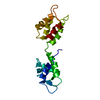 5tp5C C: citing same article ( |
|---|---|
| Similar structure data | |
| Other databases |
|
- Links
Links
- Assembly
Assembly
| Deposited unit | 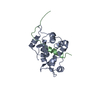
| |||||||||
|---|---|---|---|---|---|---|---|---|---|---|
| 1 |
| |||||||||
| NMR ensembles |
|
- Components
Components
| #1: Protein | Mass: 16633.330 Da / Num. of mol.: 1 / Mutation: D93A, D129A Source method: isolated from a genetically manipulated source Source: (gene. exp.)  Homo sapiens (human) Homo sapiens (human)Gene: CALM1, CALM, CAM, CAM1, CALM2, CAM2, CAMB, CALM3, CALML2, CAM3, CAMC, CAMIII Production host:  |
|---|---|
| #2: Protein/peptide | Mass: 3402.371 Da / Num. of mol.: 1 / Fragment: residues 507-531 Source method: isolated from a genetically manipulated source Source: (gene. exp.)  Homo sapiens (human) / Gene: NOS2, NOS2A / Production host: Homo sapiens (human) / Gene: NOS2, NOS2A / Production host:  |
-Experimental details
-Experiment
| Experiment | Method: SOLUTION NMR | ||||||||||||||||||||||||||||||||||||||||||
|---|---|---|---|---|---|---|---|---|---|---|---|---|---|---|---|---|---|---|---|---|---|---|---|---|---|---|---|---|---|---|---|---|---|---|---|---|---|---|---|---|---|---|---|
| NMR experiment |
|
- Sample preparation
Sample preparation
| Details | Type: solution Contents: 1 mM [U-99% 13C; U-99% 15N] CaM34, 1 mM iNOS CaM binding domain peptide, 100 mM potassium chloride, 10 mM Calcium chloride, 0.2 mM sodium azide, 90% H2O/10% D2O Label: CaM34iNOS / Solvent system: 90% H2O/10% D2O | ||||||||||||||||||||||||
|---|---|---|---|---|---|---|---|---|---|---|---|---|---|---|---|---|---|---|---|---|---|---|---|---|---|
| Sample |
| ||||||||||||||||||||||||
| Sample conditions | Ionic strength: 100 mM / Label: conditions 1 / pH: 6 / Pressure: 1 atm / Temperature: 298 K |
-NMR measurement
| NMR spectrometer | Type: Bruker DRX / Manufacturer: Bruker / Model: DRX / Field strength: 600 MHz |
|---|
- Processing
Processing
| NMR software |
| |||||||||||||||
|---|---|---|---|---|---|---|---|---|---|---|---|---|---|---|---|---|
| Refinement | Method: simulated annealing / Software ordinal: 1 | |||||||||||||||
| NMR representative | Selection criteria: closest to the average | |||||||||||||||
| NMR ensemble | Conformer selection criteria: structures with the lowest energy Conformers calculated total number: 20 / Conformers submitted total number: 20 |
 Movie
Movie Controller
Controller


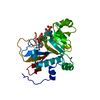
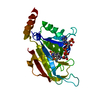

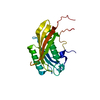

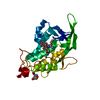
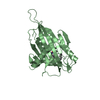
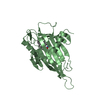
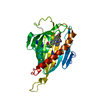
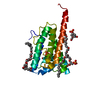
 PDBj
PDBj






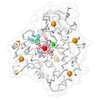















 HSQC
HSQC